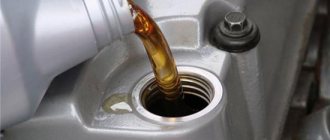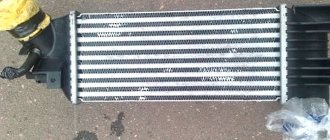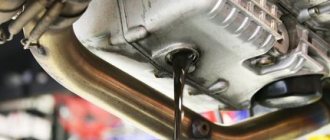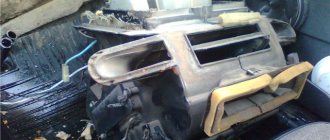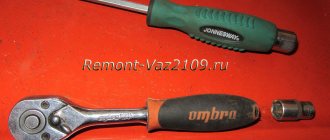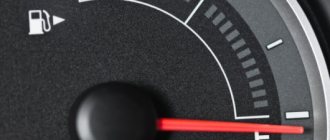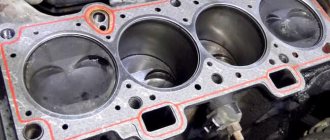Turbocharger device
If we talk about complex things in simple words, then the compressor has a very primitive design. The turbine is a casing in the form of a snail. Inside the housing there is a shaft with two blade gears. One such gear is spun by exhaust gases. The other also rotates, as it is seated on one shaft. The shaft rotation speed can be prohibitive - up to 250 thousand revolutions per minute. Therefore, the shaft must operate on high-quality bearings. Usually there are two such bearings.
Practice shows that at turbine operating speeds, not a single existing dry bearing can withstand the load under such conditions. The bearing jams, and the turbine is sent for repair. Engineers thought for a long time about how to remove excess temperature and improve glide. Oil copes well with all this - lubrication channels for each bearing are connected to the turbine shaft from the engine crankcase. Thus, the mechanism can operate at high speeds, increasing its performance and reliability.
Even a fully functional turbine will consume a certain amount of oil. The more the driver presses on the gas, the greater the consumption. Normal consumption is up to 2.5 liters per 10 thousand kilometers. Can a turbine drive large volumes of oil? It depends on the condition of the internal combustion engine.
There are two parts to a turbocharger - hot and cold. Oil channels are connected to the compressor bearings from above. One is needed for the hot part, the other for the cold part. Next, the oil, having lubricated the bearings, returns to the crankcase. But are the bearings sealed?
The bearing should not come into contact with the blades in any way and under no circumstances, otherwise in this case the turbine will drive oil on one side into the manifold or intercooler, and on the other side into the muffler. Locking rings are installed between the bearing and the impeller. The pressure supports these rings and the oil does not escape in large volumes.
Factors influencing fuel oil prices
Why do fuel oil prices fluctuate?
- The demand for fuel oil is seasonal. When crude oil prices are stable, prices for heating oil for home heating tend to rise during the winter months of October through March, when demand for heating oil is highest. A homeowner in the Northeast can use between 850 and 1,200 gallons of heating oil during a typical winter and use very little the rest of the year.
- The price of crude oil changes. The cost of crude oil is a major component of the price of heating oil. Global supply and demand determine crude oil prices. Demand will vary depending on factors such as the economy and weather. Supply may be affected by weather events in the United States and political events in other countries. The amount of oil produced by members of the Organization of the Petroleum Exporting Countries (OPEC) can also affect global crude oil prices. Visit What's Driving Crude Oil Prices? To learn more.
- Competition in local markets varies. The number of heating oil suppliers in an area can affect the level of price competition in that region. Fuel oil prices and services offered can vary significantly in areas with few suppliers compared to areas where there are a large number of competing suppliers. Consumers in rural areas, where there are fewer competitors, may pay higher prices for heating oil.
- Operating expenses may vary by region. The cost of shipping heating oil to remote locations can also affect heating oil prices. The cost of doing business can vary significantly depending on the region of the country in which the dealer is located.
Other causes of oil leaks
Oil leakage through the compressor is a common problem. Almost every owner has encountered this. The following reasons for this phenomenon can be identified:
- So, trouble occurs due to an increased oil level in the system, due to a clogged crankcase ventilation system. Owners of engines with severe wear on the piston group may encounter a problem - there is high pressure inside the engine. If the catalyst is clogged, the turbine drives oil, and this is normal. If the turbine oil drain channel is clogged, the symptoms will be the same.
- Many reasons are related to a problem with the oil drain system. It is supplied to the housing under pressure. The oil passes through the supply line, where it then mixes with air and combustion products. As a result, foam is created, which then flows down the snail body. And only then does it enter the oil drain line and then into the crankcase. If the drain channel is not wide enough or there is more oil in the engine, it will remain in the turbine housing and flow through the sealing elements.
Why sometimes all this turns out to be in vain?
First of all, you need to come to terms with this seditious thought: the shaft seals are not “one hundred percent” sealed. Under normal operating conditions, both exhaust gases and crankcase gases with oil mist still overcome them, but, we emphasize: in tiny, permissible quantities. Therefore, any working turbine consumes some amount of oil. In any turbo engine, the pressure pipes (after the compressor) will be oily. For different motors - to varying degrees, depending on their design features and technical condition. The permissible oil consumption is stipulated by the engine manufacturer, and is controlled only by the decrease in the oil level in the crankcase.
The permeability of labyrinth seals is not constant - it increases with increasing pressure difference between "inside" and "outside". Thus, the removal of oil vapor through the compressor side increases in idle mode, when there is no boost pressure and the vacuum under the compressor wheel is greatest. That is why turbocharger manufacturers advise avoiding prolonged (more than 20-30 minutes) idling of the turbo engine. During this time, a significant amount of oil in the form of oil mist enters the intake system and further into the combustion chamber. It rattled at idle, revved up, and blue smoke came out of the exhaust pipe! A severely clogged air filter makes the situation worse. With this, even at nominal engine speeds, a noticeable vacuum can be created behind the compressor wheel, provoking an increased removal of oil mist.
These phenomena, which can hardly be characterized as a turbine leak, occur during normal oil circulation in the bearing housing. The norm is when the oil, pressed through the gaps in the friction pairs, and then whipped and sprayed by a wildly rotating shaft, flows “by gravity” along the inner walls of the housing and unhinderedly returns to the crankcase through the drain tube. Now, if the oil circulation is disrupted (usually due to a decrease in drainage capacity), the cavity of the bearing housing is filled with oil and no seals will help - the turbine will “leak” in the literal sense of the word.
Draining the oil can be difficult for two reasons: the cross-section of the drain line is reduced or the back pressure of the crankcase gases is high. The tube may be pinched or clogged from the inside, the gasket may be displaced, placed on a sealant that has squeezed inward and partially blocked the hole, etc. Increased pressure of crankcase gases may be a consequence of wear of the CPG and increased breakthrough of combustion products or a malfunction of the crankcase ventilation system (clogged filter, oil separator, valve failure). Sometimes the back pressure is so great that the drainage of oil stops completely and it is squeezed out “from all the cracks”. In general, it is not without reason that the warranty documents for the turbine stipulate such requirements for the engine as the permissible resistance of the air filter and the crankcase gas pressure at idle.
All possible turbine malfunctions and their possible causes can be found in the section - Mandatory vehicle diagnostics .
From what has been said, the following axiom follows: a turbine with seals that are not worn to a critical level (especially a new turbine) will not leak on its own. If the turbine still leaks, there is an external reason that must be identified and eliminated.
The main disadvantage of the turbine
Existing experience in operating turbine engines shows that these power units have a number of problems. The main problem is related to oil leaks from the compressor. And if a turbine drives oil on some engine, then replacing it does not always help to completely solve this problem.
Oil flows from the compressor only in case of high pressure. In order for the turbine to push air through, a very large force must be applied. This force causes oil to flow through the plain bearings.
Oil line defect
The oil line should be assessed visually. It is located in most cases between the turbine and the engine crater. It is through this that oil is supplied to the compressor. This pipe is made of steel and has a complex shape. It is quite difficult to deform it, but it is possible. If the shape of the oil pipeline changes, the normal operation of the turbine is disrupted. The throughput drops and the amount of oil for normal and efficient operation of the compressor is not enough. This leads to an increase in oil pressure, which flows into the intercooler.
Intercooler
During operation of the compressor, a lot of heat is generated. This leads to certain consequences. Thus, operating efficiency decreases, since it is more difficult for the turbine to compress hot air. And due to increased loads, parts and components of the structure wear out intensively. All this was the main reason for the failure of the turbocharger. To solve this problem, an intercooler was created. It is needed to lower the air temperature to the optimal value. In the automotive industry, air and liquid radiators are used.
Gaskets
The intake manifold is secured to the power unit using gaskets. This avoids possible air leaks. The gasket also helps limit oil from entering the manifold. But over time it can become damaged. In this case, the oil still gets there. The motor may start to fail because of this. If there is a mass air flow sensor, the ECU will generate an error. All this suggests that the gasket under the manifold is damaged.
There can be many reasons for its damage. Most often, these elements fail due to wear and tear. Sometimes the gasket breaks due to overheating. However, modern elements can withstand high-temperature influences. Sometimes the gasket is damaged during engine assembly.
In this case, getting rid of oil in the intake manifold is simple - you just need to replace the gasket. Then the collector is installed back. But you need to observe some nuances. It is recommended to thoroughly clean the surfaces of the engine and manifold. The nuts are pulled with a strictly defined torque.
Reasons for oil consumption in the turbine
Before moving on to considering the immediate reasons why oil may leak, it is necessary to determine its permissible volume. The fact is that any turbine, even a fully functional one, will eat up oil. And this consumption will be greater, the higher the speed of both the engine itself and the turbine. Without going into the details of this process, it should be noted that the approximate normal oil consumption of a turbocharged engine is about 1.5...2.5 liters per 10 thousand kilometers. But if the value of a similar consumption exceeds 3 liters, then this is already a reason to think about troubleshooting.
High oil consumption
If the engine is consuming oil, this at least indicates a faulty CPG, worn oil caps or clogged crankcase ventilation. High oil consumption - signs, causes and what to do Read more
Let's start with the simplest reasons why a situation may arise when oil is driven out of the turbine. As a rule, the situation is due to the fact that the locking rings, which, in fact, prevent oil from flowing out of the turbine, wear out and begin to leak. This happens due to the fact that the pressure in the unit drops, and in turn, oil drips from the turbine to where the pressure is lower, that is, out. So let's move on to the reasons.
Clogged air filter . This is the simplest situation, which, however, can cause this problem. You need to check the filter and, if necessary, replace it (in rare cases, you can clean it, but it’s still better not to tempt fate and install a new one, especially if you use the car off-road). In winter, instead of or along with clogging, in some cases it may freeze (for example, in conditions of very high humidity). In any case, you definitely need to check the condition of the filter.
Methods for determining malfunction
You should check the exhaust of your car not at idle speed, but under load, or sharply increase the gas. You can also drive behind this car and observe what color the exhaust gases are, which is key for correct diagnosis. If there is a bluish tint in the car exhaust when the engine is idling, there is a high probability that after driving a hundred or two kilometers, the car will stop driving completely. To analyze the exhaust of a car, a flat and long gentle slope is suitable, along which you need to drive, reach a certain speed, turn on neutral gear and start coasting. At the end of the descent, you need to turn on the gear and quickly press the gas pedal. If the car engine has any problems, it will emit bluish-colored smoke, which is clearly visible even from afar.
How much oil should a turbocharged engine consume?
Automakers have taken a course away from classic naturally aspirated engines and switched to the production of turbocharged engines of small volume but high power. Many motorists are not at all happy about such changes, as they consider this type of engine less reliable.
Quite often you can hear complaints that a turbocharged engine consumes a lot of oil, and it has to be topped up regularly. But can this fact be considered a disadvantage, what kind of oil content should a turbo engine have?
Deformation of the cylinder head or its components
This is another reason why the intake manifold is covered in oil. Various cylinder head malfunctions occur here. Due to damage or wear, some cylinder head parts are unable to come together tightly and hermetically. Nothing prevents oil from entering the manifold. Often this problem can be accompanied by a white coating in the oil, and the engine may also lose power. It is simply impossible not to notice these “symptoms”.
You can also highlight the large production of valve guides in the cylinder head. If this occurs, then the valves are practically not lubricated - this is where the oil in the intake manifold comes from. Next, the lubricant enters the cylinders, where it burns safely.
What to do if the turbine is leaking
There are many reasons for oil leakage from a turbocharger, but if only the turbine itself is to blame, it needs to be replaced:
- • high-quality repair of a turbocharger can only be performed by highly qualified specialists; there are few professionals in this matter;
- • the cost of such work is high, in many cases it is comparable to the price of a new turbine, or may even be higher.
If you determine that oil is leaking through the turbocharger, it is recommended to immediately contact qualified technicians at a service station.
Damaged air duct
Cracks may form in the duct housing. They contribute to the formation of a vacuum zone. This will cause oil to flow from the high pressure area to the low pressure area. Then the oil will cause damage to the sealing elements and gaskets. The vacuum zone will expand, and in this case the oil will flow like an avalanche or tsunami.
Non-critical damage can be fixed. And if it is impossible to fix, then it is necessary to urgently change it, since operation in this mode will lead to the need to clean the compressor.
Clogged filter
Car owners often forget about air filters and do not change or clean them. But it plays an important role in the operation of supercharging. Dirty air leads to disturbances in the operation of the turbine. If the filter does not clean the incoming air well, it does not supply enough air. As a result, oil is driven through the turbine directly into the cooling system.
Clogged catalyst and turbine
When the catalyst is clogged, resistance also appears at the exhaust gas outlet. This leads to increased load on the compressor rotor. If you continue to use the car, this will result in increased fuel consumption, decreased dynamics and power. This also leads to wear on the bearings in the turbine. That's why the turbine drives oil.
Main causes of failure
Simple solutions
If you find oil in the intercooler, do not panic - it is quite possible that you will only need a couple of hours to eliminate this problem. First of all, check the condition of the oil drain pipe, which is laid between the turbine and the engine crankcase; it should be straight and not contain significant bends. When the drain pipe is bent, increased pressure occurs in the turbine, which forces the oil to be forced through the seal rings and into the intercooler. As a rule, this pipeline is made of dense, rigid material, but during prolonged use it can become deformed. The solution is simple - align the oil line and secure it in this position.
If the turbine throws oil into the intercooler, also inspect the air duct leading to it - there should be no cracks or holes in it. The reason could be that the filter is very clogged, which does not allow enough air to pass through. In both cases, a vacuum zone forms inside the supercharger, which extracts oil and gradually destroys the seal rings, contaminating the intercooler. The solution is to clean the filter and replace it as soon as possible, as well as repair any holes in the air duct.
Serious problems
Sometimes it’s so easy to get rid of problems that have arisen without success - oil in the intercooler pipe appears as a result of a disruption in communication with the engine crankcase. The reason may be the formation of various types of blockages in the oil drain pipe - from debris getting into it to the appearance of carbon deposits. Very often, car enthusiasts who independently repair a diesel engine use not special means to secure the oil line, but ordinary sealants, which, when heated, penetrate inside the tube and form blockages. The solution to the problem is to remove the oil drain pipe, thoroughly clean it and rinse it, being careful not to damage the walls of the tube.
However, this is not the worst case scenario - it is quite possible that the lubricant in the crankcase rises above the level of the drain pipe, and as a result, the turbine throws oil into the intercooler. It’s good if you simply went too far with the amount of oil used - but if the crankcase ventilation is impaired, the situation will not be so easily corrected. One of the reasons for the problem may be a violation of the integrity of the sealing rings in the cylinder-piston group, as a result of which exhaust gases will enter the crankcase and squeeze out the oil through the drain pipe. The solution is a major overhaul of the engine with replacement of rings.
On the importance of timely diagnosis
Oil in the engine power system leads to fatal consequences. This is turbine breakdown, coking of rings, burnout of pistons and valves and other troubles. Even a slight appearance of oil in the intercooler should alert the owner. It is necessary to stop operating the car and carry out diagnostics. This will save you from replacing units and costly engine repairs.
Oil getting into the intercooler is a common malfunction of turbocharged engines. It is caused by the design and operation features of the turbine. An unpleasant symptom that signals that the engine needs to be given close attention. This problem cannot simply be left like that. If self-diagnosis does not clarify the situation, you need to contact a professional.
Diesel engine turbine oil
Each turbine has its own resource. But often the symptoms of a turbocharger failure become apparent before the service life stated by the manufacturers. The main root causes of problems are related to oil. It begins to flow from the scroll and enters the intake, as well as the intercooler or air filter pipes.
Oil leakage through turbine housing seals
This happens due to overheating of the turbocharger, shock to the turbine, use of dirty oil, wear of parts of the cylinder-piston group and other root causes. Typically, breakdowns occur if the turbocharging system is not serviced in a timely manner: filter replacement schedules are overdue, low-quality oil is used, etc.
If oil is leaking from the turbine, the drainage system should be checked. Sometimes it happens that the oil drain channel becomes clogged. Then the oil is retained in the turbine housing and begins to flow through the seals. The drain should not be bent. In addition, the drain line must be located above the lubricant level in the sump of the power unit.
It happens that oil leaks from the turbine due to a clogged catalyst . When it becomes clogged with soot, resistance to exhaust gases appears. At the same time, the load on the TKR rotor increases significantly, causing play, the turbine bearings quickly wear out, fuel consumption increases and engine power decreases. This cannot be done without repairing or even replacing the turbocharger.
Example of a clogged catalyst
The outside of the turbine is covered in oil
If there are oil leaks outside the turbine, the first thing to do is look for the cause. Check the tightness of the connection between the turbine and the cold part of the turbocharger . Perhaps the pipes are worn out or it’s time to replace the clamps.
The outside of the turbine is covered in oil
It is not uncommon for a leak to appear from the turbine core. Here you will need to tighten the flanges of the oil pipes . Sometimes you have to change the gaskets right away. When tightening the flanges, the main thing is not to overdo it and not to overtighten the fasteners.
Oil leak from turbine sertivina
It happens that there is a leak at the junction of the diffuser disc and the turbocharger core. In such a situation, you need to figure out what kind of liquid is leaking from the turbine. In older TKR models, a special lubricant used to ensure tight connections may drip. You will have to remove the turbocharger to carry out diagnostics. It is impossible to do without repairing the turbine if there are heavy oil leaks in the air valves.
New pipes and tightened fastenings do not always help correct the situation. If oil reappears outside the housing, the turbine may need to be repaired or replaced with a new one.
Oil in the cold part of the turbine
Problems in the cold part of the turbine usually arise due to damage or breakdown of neighboring vehicle systems . However, there are times when oil appears between the air filter and the engine, inside the air duct. Lubricant enters the air pipes through the breather, which is responsible for removing crankcase gases .
Oil inside the duct
The reason lies in the abnormally increased gas pressure. Since the intake and exhaust systems are interconnected, a failure in the operation of some mechanisms affects the functioning of others. As the pressure in the crankcase increases, the pipe inside becomes covered with an oil film.
Oil is thrown into the cold part of the turbine and the pipes from the air filter due to many factors: a dirty air filter, a clogged muffler, destruction of the piston partitions and various breakdowns of the cylinder-piston group . And sometimes grease getting into the pipe is a consequence of problems with the crankcase ventilation system.
Eliminating the root causes of oil getting into the turbine air pipe:
- If there is excess oil in the diesel engine crankcase, it must be drained. The grease level on the dipstick should be in the middle (between MAX and MIN).
- Due to a clogged air filter, the engine does not have enough air and sucks gases from the crankcase through the breather. Oil vapors settle in the air duct. The only correct solution is to replace the dirty air filter.
- When the crankcase ventilation system is not working, gas pressure increases excessively in the hose between the valve cover and the throttle valve, as well as in the passages in the cylinder block. Gradually, resin collects in these nodes and coking occurs, the lumen of the channels becomes clogged. In such a situation, you need to clean all channels.
- If the catalyst has melted, you will have to clean the exhaust system.
It happens that the reason lies in the occurrence of compression rings or in the destruction of the cylinder walls. In addition to lubrication in the air filter pipe, there are problems with starting the engine, too smoky exhaust, as well as unstable idling. It is difficult to fix such a problem at home in the garage; it is better to immediately contact the service.
Oil in the hot part of the turbine
When lubricant gets into the hot part of the turbocharger, increased fuel consumption occurs, the turbine begins to consume oil, engine power decreases, and the color and smell of the exhaust also changes. Oil leaks will be visible on the throttle body and outside the air filter.
Oil in the intake manifold
The turbocharger often throws oil into the exhaust or intake manifold not due to its own failure, but due to a malfunction of neighboring components , for example, the crankcase ventilation system of the power unit. When the ventilation fails to do its job, excess gas pressure forms in the crankcase and the oil is difficult to drain through the turbine drain line. In the bearing housing, the lubricant is “backed up” and begins to have a negative effect on the turbocharging components. The situation may occur due to the following factors: pinching, fracture or coking of the crankcase ventilation system pipe, as well as coking of the oil separator.
The turbine throws oil into the manifold and if foreign objects get into the drain line, for example, remnants of sealant or pieces of an old gasket. Coked lines are also common.
Oil may appear in the hot part of the cochlea due to insufficient air intake from the turbine. Here you need to inspect the air filter and air intake pipe.
On the compressor side, the turbine begins to drive oil when the exhaust system malfunctions. When exhaust is obstructed, the pressure in the hot end of the turbocharger increases too much. Exhaust gases penetrate into the middle housing of the TCR, increasing the pressure there too - this causes the release of lubricant from the compressor.
What needs to be done to normalize blood pressure?
To do this, when installing the turbine unit, it is necessary to perform certain actions, in particular:
- Find out the condition of the filter; if it is dirty, you need to either clean it or replace it.
- It is necessary to check the condition of the air filter box and intake pipe. If necessary, they will need to be cleaned.
- Find out how airtight the box and filter cover are. If it is damaged, foreign particles may enter the internal parts of the turbine and this will sooner or later lead to its failure.
- In addition to the above operations, it is necessary to clean all pipes installed in this unit. During assembly, you must ensure that no foreign particles get inside.
Important! If a decision was made to replace the turbine unit and the specified measures were not taken, then the likelihood is that the installed turbine will begin to ooze oil.
Additional operations that must be performed when servicing or replacing the turbine:
It is necessary to replace the engine oil poured into the engine. The whole point is that foreign particles that are in the oil will sooner or later settle on the surface of the bearings and the compressor will be jammed after some time.
Important! To avoid foreign particles getting into the oil, it is unacceptable to use sealing compounds. Over time, they dry out and begin to break down, forming small solid particles.
Unfortunately, not all car locksmiths know and perform the above operations. Therefore, when purchasing a turbine in a specialized store, you need to take the installation instructions, study them yourself and demand that the mechanic installing the compressor strictly follow them. In this case, it is not particularly important whether the compressor will be replaced in the field or at a service station.
The most common breakdowns in the turbocharging system
During the operation of a car, a turbocharged engine is subject to wear and tear, since all components and assemblies of the internal combustion engine have their own specific resource. Also, turbine parts wear out over time, but the turbocharger can fail ahead of schedule, and the main causes of malfunctions here are as follows:
- • dirty oil is used in the engine;
- • there was an impact that damaged turbine parts;
- • there is not enough oil in the engine;
- • the turbocharger has overheated.
Mostly, breakdowns in the turbocharging system occur due to violations of vehicle operation rules and untimely maintenance.
Crankcase ventilation
Malfunctions of the crankcase ventilation system are another possible cause of increased oil consumption. Inevitable deposits over time significantly reduce the performance of the oil separator and reduce the life of the ventilation control valve or cause it to operate incorrectly. As a result, much more liquid oil enters the intake air tract; it burns in the cylinder, leaving behind carbon deposits on the pistons and valves.
Rare cases
Now let's look at more rare, private cases, which, however, sometimes bother car enthusiasts.
Mechanical damage to the turbine . In particular, this may be due to an accident or other accident, the impeller getting hit by some foreign heavy object (for example, a bolt or nut left after installation), or simply a defective product. In this case, unfortunately, repairing the turbine is hardly possible, and it is better to replace it, since the damaged unit will still have a much lower service life, so it will be unprofitable from an economic point of view.
For example, there is an oil leak outside the turbine on the compressor side . If the diffuser disk is attached to the core using bolts, for example, as is implemented in the Holset H1C or H1E turbochargers, then perhaps one of the four mounting bolts has reduced the tensioning torque or has broken. It is less likely to be lost due to vibration. However, if it is simply not there, you need to install a new one and tighten all the bolts with the required torque. But when the bolt breaks and its inner part gets into the turbine, it needs to be dismantled and try to find the broken part. In the worst case scenario, replace it completely.
Leaking from the connection between the diffuser disk and the volute . The problem here is that you need to make sure that oil is leaking from the mentioned connection. Since older models of turbochargers used a special thick lubricant to ensure their tightness. However, during operation of the turbine, under the influence of high temperatures and damage to the seals, this lubricant may leak out. Therefore, for additional diagnostics, it is necessary to dismantle the snail and find out whether there are oil leaks inside the air valves. If there are none, and instead there is only moisture, then you don’t have to worry, wipe it with a rag, and put the entire unit back to its original state. Otherwise, you need to perform additional diagnostics and use one of the tips above.
High oil level in the crankcase . Occasionally, in turbocharged engines, excess oil may leak out of the system due to its high level in the crankcase (above the MAX mark). In this case, it is necessary to drain the excess lubricant to the maximum permissible level. This can be done either in a garage or in a car service center.
Engine design features . In particular, there are cases where some engines, due to their design, themselves created resistance to the gravity drain of oil from the compressor. In particular, this happens because the counterweight of the engine crankshaft, with its mass, seems to throw the oil back. And here nothing can be done. You just need to carefully monitor the cleanliness of the engine and the oil level.
Wear of elements of the cylinder-piston group (CPG) . In this case, a situation is possible when exhaust gases break into the oil pan and create increased pressure there. This is especially aggravated if the crankcase ventilation does not work correctly or not fully. Accordingly, gravity drainage of oil is difficult, and the turbine simply expels it from the system through weak seals. Especially if the latter are already old and leaky.
Clogged breather filter . It is located in the crankcase ventilation system and can also become clogged over time. And this, in turn, leads to its incorrect operation. Therefore, along with checking the functionality of the ventilation, it is necessary to check the condition of the specified filter. If necessary, it must be replaced.
Incorrect turbine installation . Or another option is to install a obviously low-quality or faulty turbine. This option, of course, is rare, but if you performed repair work at a car service center with a dubious reputation, then it also cannot be excluded.
Disabling the EGR valve . Some car enthusiasts, in a situation where the turbine “eats up” oil, advise turning off the EGR valve, that is, the exhaust gas recirculation valve. In fact, such a step can indeed be taken, but it is necessary to further become familiar with the consequences of this action, since it affects many processes in the engine. But remember that even if you decide to take such a step, you will still need to find the reason why the oil is being “eaten up”. After all, at the same time, its level constantly drops, and engine operation in conditions of oil starvation is very harmful for the power unit and turbine.
Extending turbocharger life
The main cause of oil leakage through the turbine is excess pressure created in the engine crankcase; to prevent it from occurring, it is necessary to regularly carry out a number of preventive measures. You should also not forget about timely maintenance; automotive repair professionals advise doing the following :
- • change the engine oil and oil filter in a timely manner; dirt in the oil system has a detrimental effect on the turbine and “kills” it;
- • check the condition of the air filter even if it is not yet due for replacement. At the same time, not only the filter element itself is inspected, but also the filter housing and air pipe;
- • periodically remove and clean the pipes coming from the turbocharger;
- • check the tightness of the air filter housing itself. If the box is not sealed, dust will bypass the filter element and get onto the turbocharger impeller.
When operating a car with a turbocharged engine, you cannot skimp on consumables: you should only fill the engine with high-quality motor oil and use original-made filters. You also need to remember that a production car with a turbo engine is not intended for racing, although it has a fairly powerful power unit.
If a turbine fails, its replacement should be trusted to professionals, and not rely on your own strength. There are many examples where independent installation and dismantling of a turbocharger led to disastrous results, and the car owner had to pay dearly for his unskilled work.
The turbine drives oil - why?
The main cause of this malfunction is excess oil pressure in the turbocharger, which leads to the release of oil into the turbine compressor housing, and then along with air into the engine combustion chamber.
Excessive oil pressure in the turbine can occur for the following reasons:
- the crankcase ventilation tube is clogged;
- the oil drain pipe from the turbine is deformed;
- The oil drain holes from the turbine are clogged.
The most common causes of clogging of the oil inlet and oil outlet pipes of a turbocharger are untimely oil changes and adding oil of a different brand and with other characteristics during the operation of the vehicle, or the use of low-quality oil. This leads to the oil losing its lubricating properties and the formation of deposits of solid particles, as a result of which the turbocharger becomes clogged and fails.
The turbine can also drive oil due to wear of the sealing rings, which are located in the turbocharger housing. This defect can be caused by the ingress of small metal particles into the oil or other elements that have abrasive properties.
What can cause oil leakage from a turbine?
When the turbine drives oil, this will lead to a significant increase in engine oil consumption. A characteristic sign of this malfunction is the presence of bluish smoke in the exhaust. Also, increased oil emissions can lead to damage to the turbocharger.
Oil outlet from exhaust pipe
The release of oil from the exhaust pipe of a car, in most cases, is accompanied by the appearance of bluish smoke or other shades. In addition, a flame may appear from the exhaust pipe. Oil leakage into the exhaust pipe naturally leads to increased oil consumption. In this case, it is necessary to measure its level quite often and top it up. Some car enthusiasts wait until the light on the car's control panel comes on, indicating that the engine oil will soon run out. Thus, they make a big and serious mistake. This especially applies to drivers of Zhiguli cars, in which this warning light comes on only after less than a liter of oil remains in the car’s engine, and this risks causing the car’s engine to stop and jam.
Pipes
This is another reason. If the oil has not been changed for a long time, the pipes tend to become clogged. Even if the turbine is repaired, the pipes are cleaned. It is very important. If the oil is under the intake manifold, then a pressure difference occurs due to the pipes or filter. It is also important to monitor the tightness of the air elements; if the pipes have cracks or other signs of deformation, they should be replaced with new ones.
Otherwise there will be excessive air leaks. This is harmful for both turbocharged and naturally aspirated engines. The problem is further aggravated by the fact that unpurified, dirty air gets through these cracks, bypassing the filter. And the presence of dust in the cylinders of internal combustion engines leads to premature wear of the piston group.
